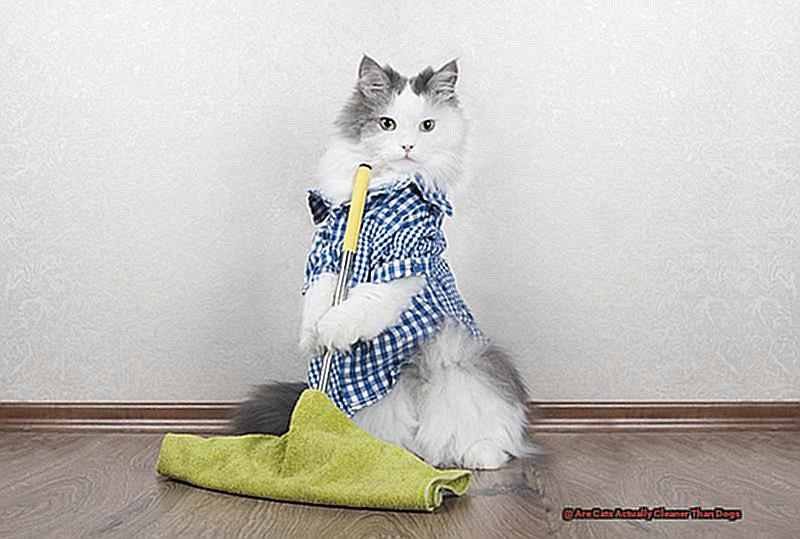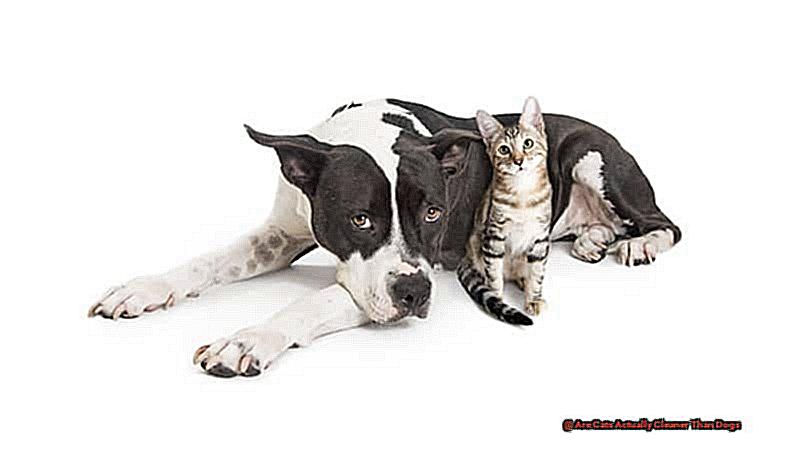Cats versus dogs – the ultimate rivalry in the world of pets.
But amongst all the bickering and banter, there’s one question that always seems to divide pet owners: who is cleaner? While some may argue that cats’ meticulous grooming habits make them the clear winner, others swear by their dog’s frequent baths and lack of litter box odors.
As a self-proclaimed cat lover, I’ve always been quick to defend my feline friends’ cleanliness. But recently, I found myself questioning whether this was just a biased opinion or if there was actually truth behind it.
Get ready for some intriguing facts and opinions – this is a debate that will have you wagging your tail with excitement.
Are Cats Actually Cleaner Than Dogs?
Contents
As a cat expert, I have heard this question countless times: “Are cats cleaner than dogs?” It’s a common belief that cats are the epitome of cleanliness with their constant grooming and fastidious litter box habits. But as with any stereotype, the truth is not always so simple. So let’s dive into this topic and uncover the facts about feline and canine cleanliness.
Grooming Habits: Advantage Cat or Dog?
One of the main reasons cats are perceived as cleaner than dogs is because of their self-grooming habits. Cats spend a significant amount of time licking and cleaning themselves, thanks to their rough tongue with tiny barbs that act as a natural brush. This helps them remove loose fur, dirt, and debris from their coat. On the other hand, dogs have a smooth tongue and may not be as efficient in removing debris.
Living Environment: Indoor Cats vs Outdoor Dogs
Another factor to consider is the living environment of the pet. Indoor cats may seem cleaner as they do not have access to dirt or other outdoor elements. However, outdoor dogs can come into contact with all sorts of substances like mud, dirt, and even feces. This can make them appear less clean, but it’s important to remember that both cats and dogs carry bacteria and parasites on their fur.
Litter Box vs Potty Training
Cats are known for their impeccable litter box habits, while dogs may have accidents inside the house or require regular walks outside for bathroom breaks. This can contribute to the perception that cats are cleaner than dogs. But as any cat owner knows, litter boxes need to be cleaned regularly to avoid any unpleasant odors or bacteria growth.
Shedding: The Great Equalizer?
Another factor to consider is shedding. Dogs may shed more evenly throughout the year, while cats tend to have a heavy shedding period once or twice a year. This can lead to more visible fur around the house during those periods. So while cats may appear cleaner on a daily basis, the truth is that both pets shed and require regular grooming to keep their coats in good condition.
Understanding the types of coats in cats and dogs
As a cat owner, you may have heard the age-old saying that cats are “cleaner than dogs.” But is there any truth to this statement? As an expert on understanding the types of coats in cats and dogs, I can confidently say that the answer is not as simple as it may seem. There are several factors that contribute to the perceived cleanliness of these two animals, and it’s important to understand them in order to properly care for and appreciate our furry friends.
Self-grooming Behavior
One of the main reasons why cats appear cleaner than dogs is their unique self-grooming behavior. Cats are meticulous groomers, spending up to 50% of their waking hours grooming themselves. This behavior not only helps them stay clean but also promotes blood circulation and distributes natural oils throughout their coat, keeping it healthy and shiny. On the other hand, dogs do not have this same self-grooming behavior and therefore require more frequent baths and brushing to maintain cleanliness.
Coat Types
Another factor to consider is the type of coat each animal has. Cats typically have a smoother coat that is less likely to trap dirt and debris, making it easier for them to maintain cleanliness. Dogs, on the other hand, have a variety of coat types including curly, wiry, and long coats that may require more maintenance to keep clean. This can also vary depending on the specific breed of dog.
Shedding Patterns
Excessive shedding can also contribute to the perceived cleanliness of cats and dogs. Some dog breeds are known for their excessive shedding, which can make them appear dirty even if they are regularly groomed. Cats, on the other hand, shed less and their grooming habits help minimize the amount of loose hair on their coat.
Environmental Factors
The living environment of these animals also plays a role in their cleanliness. Cats are typically indoor animals and have a designated litter box for their bathroom needs. This helps contain any mess and reduces the need for external cleaning methods like baths. Dogs, on the other hand, may require more frequent baths due to their active lifestyles and tendency to get dirty while playing outside or going for walks.
The impact of living environment on pet cleanliness
Let’s dive into the details and compare cats and dogs in terms of their living environments and how it affects their cleanliness.
Indoor vs. Outdoor Living:
One of the main differences between cats and dogs is their natural habitat. Cats are typically kept indoors, while dogs may be kept either indoors or outdoors. This means that cats are exposed to less dirt and germs compared to outdoor dogs. Indoor cats also have access to a litter box, which they use as a designated spot for elimination. This helps contain their waste and reduces the chances of spreading bacteria or parasites in their living space.
On the other hand, outdoor dogs have a higher chance of being exposed to dirt, bacteria, and parasites. They also tend to use different areas in their living space for elimination, which can make it challenging to keep their environment clean.
Grooming Habits:
Cats are known for being fastidious groomers, spending a significant portion of their day cleaning themselves. This instinctual behavior has earned them the reputation of being one of the cleanest animals. On the other hand, dogs have a more playful and active nature, which may lead to them getting dirty more often.
But here’s the catch – while cats may have a natural inclination towards cleanliness, their living environment and level of care play a significant role in maintaining their hygiene. If they are not provided with a clean living space or lack proper grooming tools, they may not be able to maintain their cleanliness effectively.
Bathing and Grooming:
Another factor that affects pet cleanliness is the level of care and attention given by their owners. As mentioned earlier, cats are natural groomers and will clean themselves regularly. However, dogs require regular bathing and grooming to keep them clean. With proper care and grooming, dogs can be just as clean as cats.
Natural behaviors of cats and dogs when it comes to grooming
As a dog owner, you may rely on regular baths and brushing to keep your furry companion clean. But have you ever wondered why cats and dogs have such different approaches to grooming? As an expert on the natural behaviors of these animals, I am here to explain how their grooming habits contribute to their overall cleanliness.
Cats are known for their meticulous grooming habits, spending hours a day licking and grooming themselves. This is because they have rough tongues that are perfect for removing dirt and loose fur from their coats. They also have specially designed grooming claws on their front paws that help them to remove any stubborn bits of dirt or debris. This natural behavior not only keeps their coat clean but also helps to distribute natural oils, keeping their skin healthy.
On the other hand, dogs have a different approach to grooming. While some may groom themselves, it is not as frequent or thorough as cats. Dogs rely more on their owners to keep them clean through regular baths and brushing. This is because dogs do not have the same grooming abilities as cats, and their tongues are not designed for grooming.
But it’s not just self-grooming that contributes to the cleanliness of cats and dogs. Cats have a unique behavior called self-anointing, where they rub saliva onto their fur after encountering a new scent or taste. This helps to keep their coat clean and remove any foreign odors. Dogs do not have this behavior, which may contribute to a less clean coat overall.
Another interesting difference between cats and dogs is their approach to waste management. Cats instinctively bury their waste in litter boxes, which not only keeps their immediate environment clean but also prevents the spread of bacteria and parasites from their feces. Dogs, on the other hand, may leave their waste on the ground or require outdoor walks for elimination, which can lead to a messier environment.
Additionally, cats have a natural behavior of grooming each other as a form of social bonding and hierarchy maintenance. This ensures that all cats in the group are clean and free from parasites. Dogs may also engage in mutual grooming, but it is not as common or necessary for their social interactions.
Bacteria and parasites carried by both cats and dogs
It’s fascinating to see how effortlessly she keeps herself clean. But did you know that while cats may seem like experts at maintaining their hygiene, they can also carry bacteria and parasites that can be harmful to humans? And dogs are not exempt from this either. As an expert on these organisms, I want to inform my fellow cat owners about the potential health risks associated with our furry companions.

Bacteria: More Than Just a Case of Food Poisoning
Cats can carry bacteria such as Salmonella, which can cause food poisoning in humans. But it’s not just cats who are to blame. Dogs can also carry bacteria like E. coli and Campylobacter, which can cause diarrhea and other digestive issues in humans. These bacteria can easily be transmitted to humans through contact with contaminated surfaces or even through consumption of infected prey.
Parasites: Not Just a Feline Problem
Parasites are another concern when it comes to our pets. Roundworms, tapeworms, and hookworms are just some of the parasites that both cats and dogs can carry. These pesky organisms can be transmitted to humans through contact with their feces, causing a range of health issues such as abdominal pain, anemia, and even blindness.
Don’t Be Fooled by Clean Fur
It’s important to note that the cleanliness of your cat or dog’s fur does not necessarily reflect their level of bacterial or parasite contamination. Both cats and dogs groom themselves, but they can also pick up bacteria and parasites from their environment through contact with contaminated surfaces or consuming infected prey.
Prevention is Key: Regular Grooming and Hygiene Practices
So, what can we do to protect ourselves and our furry friends from these harmful organisms? Regular grooming and hygiene practices are crucial. It’s essential to wash your hands after handling your pets and to clean their litter boxes or pick up their feces promptly. These simple steps can significantly reduce the risk of bacterial and parasite transmission.
The role of saliva in keeping pets clean
As pet owners, we all know the struggle of keeping our furry companions clean and smelling fresh. But have you ever stopped to wonder how cats and dogs manage to stay so pristine? The answer lies in their saliva – a seemingly unassuming bodily fluid that plays a crucial role in maintaining their cleanliness. In this post, we will explore the importance of saliva in grooming cats and dogs, and how understanding its composition can help us keep our pets clean and healthy.
The Power of Cat Saliva
Cats are known for their impeccable grooming habits, spending hours upon hours each day cleaning themselves. But what makes them such effective groomers? It all comes down to their saliva. Cats have a rough tongue with tiny papillae, which act as tiny barbs to remove dirt and debris from their fur. Additionally, their saliva contains enzymes that help break down and digest any dirt or bacteria present on their coat. This means that as they lick themselves, they are not only removing dirt but also disinfecting their coat.
But it’s not just about cleanliness; cat saliva also has antimicrobial properties that help keep them free from harmful bacteria. This is especially important for outdoor cats who may come into contact with various bacteria and parasites. So next time your cat gives itself a thorough clean, remember that it’s not just for vanity – it’s an essential part of their hygiene routine.
The Struggle of Dog Saliva
Unlike cats, dogs’ saliva is not as efficient in keeping them clean. While they do have some enzymes in their saliva, they have fewer papillae on their tongues, making it less effective in removing dirt and debris from their fur. This means that dogs rely more on external grooming from their owners or professional groomers to maintain their cleanliness.
Furthermore, dogs’ habit of sniffing and licking everything they come across puts them at a higher risk of picking up bacteria and parasites. This can lead to unpleasant odors and potential health issues if not properly cleaned.
Grooming and Hygiene Practices for Cats and Dogs
Understanding the role of saliva in keeping cats and dogs clean can help us establish proper grooming and hygiene practices for our pets. While cats may require less external grooming, regular brushing can help remove excess hair and prevent hairballs. It’s also essential to keep their litter box clean to prevent the spread of bacteria.
Maintaining cleanliness in both cats and dogs
As a cat owner, I’m sure you’ve marveled at the seemingly endless hours your feline friend spends grooming themselves. But did you know that this constant self-grooming is not just for show? Cats are naturally clean creatures, and their saliva plays a big role in maintaining their impeccable cleanliness. In this guide, I will share my expertise and insights on the importance of regular cleanliness for cats and how you can help keep your furry friend fresh and healthy.
The Power of Self-Grooming
It’s no secret that cats are notorious for their meticulous grooming habits. In fact, they spend up to half of their waking hours grooming themselves. This constant grooming helps them maintain a clean and shiny coat, removes dirt and debris, and even promotes blood circulation. So next time you see your cat giving themselves a good lick, know that they are not just being vain – they are taking care of their hygiene.
Litter Box vs. Backyard Waste
One advantage of having a cat is that they use a litter box, which can be easily cleaned and maintained by their owners. This means less mess and less time spent cleaning up after them. On the other hand, dogs require regular cleaning up of their waste in the backyard, which can be messy and time-consuming. So if you’re someone who values convenience, a cat may be the better choice for you.
Clean Mouths = Clean Surfaces
It’s a common misconception that cats have dirty mouths due to their habit of licking themselves. However, research has shown that their saliva contains enzymes that act as a disinfectant against harmful bacteria. This means that cats are less likely to transfer bacteria onto surfaces or objects in the home compared to dogs. So while we may cringe at the thought of our cats constantly licking themselves, know that it’s actually helping to keep them clean and healthy.
Indoor Lifestyle
Another factor to consider is that cats are strictly indoor animals, while dogs often go outside for walks or playtime. This means that dogs may track in more dirt, mud, or other outdoor debris into the house compared to cats who stay mostly indoors. So if you’re someone who values a clean living space, a cat may be the better fit for you.
Conclusion
The age-old rivalry between cats and dogs has sparked many debates among pet owners, but one question always seems to divide them: who is cleaner? This topic has been a subject of speculation for centuries, with some claiming that cats’ meticulous grooming habits make them the clear winner, while others argue that dogs’ frequent baths and lack of litter box odors give them the upper hand.
As a self-proclaimed cat lover, I have always been quick to defend my feline friends’ cleanliness. But as I delved deeper into this topic, I began to question whether my opinion was simply biased or if there was actually truth behind it. After reading through a comprehensive article discussing various factors such as grooming habits, living environments, shedding patterns, and natural behaviors of cats and dogs, I can confidently say that the answer is not as straightforward as it may seem.
It’s true that cats have a natural inclination towards cleanliness with their constant grooming and fastidious litter box habits. Their rough tongue with tiny barbs acts as a natural brush to remove dirt and debris from their coat while their saliva contains enzymes that help break down bacteria. However, let’s not forget that dogs also have their own unique ways of staying clean. Their saliva contains enzymes that can help break down bacteria, and regular brushing can keep their coats in good condition.
Moreover, the living environment plays a significant role in the perceived cleanliness of these animals. Indoor cats may seem cleaner since they do not have access to outdoor elements like mud or dirt. However, outdoor dogs are more likely to come into contact with various substances which can make them appear less clean but does not necessarily mean they are inherently dirty.
Additionally, understanding the different types of coats in both cats and dogs is crucial. Cats typically have smoother coats that are less likely to trap dirt while dogs have a variety of coat types which may require more maintenance to keep clean.
But when it comes down to it, both cats and dogs can carry bacteria and parasites that can be harmful to humans. Therefore, regular grooming and hygiene practices are essential for both pets. And while cats may seem like experts at maintaining their hygiene, they still require proper care and attention from their owners.
In conclusion, the debate of who is cleaner between cats and dogs may never truly be settled. Each animal has its own unique ways of staying clean, and it ultimately depends on individual preferences and lifestyles.






